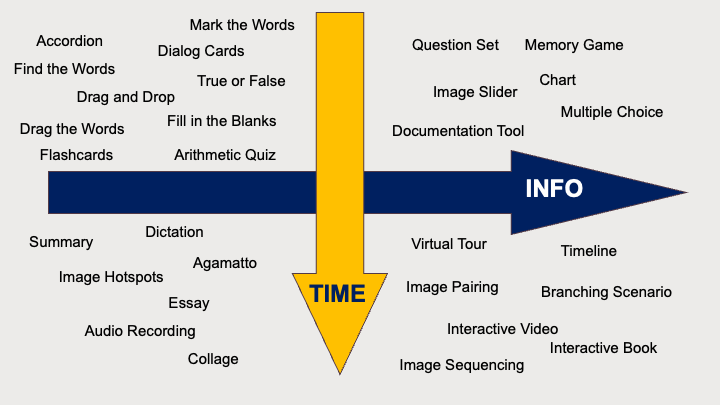H5P: What, Why, and When
H5P is a free, open-source tool that allows users to create web-based interactive learning activities. It is a plug-in that allows users to create interactive content in an existing authoring platform (WordPress, Pressbooks or through an LTI with a Learning Management System- FOL). H5P stands for HTML5 Package, the latest version of the standard markup language used to structure and present content on the web.
![]() The best way to learn about H5P is to explore the many content types. The following section provides examples of the different content types available. It is essential not to use it just because it exists – but to consider how it will serve you in your teaching and learning context.
The best way to learn about H5P is to explore the many content types. The following section provides examples of the different content types available. It is essential not to use it just because it exists – but to consider how it will serve you in your teaching and learning context.
Why create H5P?
There are some powerful reasons to create H5P for Pressbooks:
- Help students achieve chapter learning objectives. Each interactive will deepen a student’s understanding of the key terms, skills, or concepts that guide the chapter.
- Give students more opportunities to check comprehension. Learner interaction, discovery, and agency allow students to shift from passive to active learners. Interactives in the text reinforce and interleave content, supporting new learning pathways.
- Increase the relevance and overall appeal of the Pressbook. Future educators and adopters look for built-in student interaction.
When to Use H5P
Everyone’s teaching and learning contexts are different – but one aspect that rings true for all is we don’t want to overcomplicate or introduce elements when they don’t have a purpose. When considering using H5P for your course or resource, evaluate whether it supports the following key principles:
- The H5P aligns with the intended learning outcomes
- The H5P provides an opportunity to incorporate multimedia (multiple modes) to help manage cognitive load during learning.
- The H5P allows learners to engage with the content – supporting active learning.
The following chart will help you consider how you might use H5P for various teaching and learning purposes.
| Tools for Formative Assessment |
Multiple Choice |
|---|---|
| Tools for Unit/Content Review |
Course Presentation |
| Tools for Multimedia Integration | Interactive Videos Branching Scenario Image Hotspots |
| Tools for Student Submissions* | Questionnaire Audio Recorder Essay Documentation Tool |
| Tools for Knowledge Application | Branching Scenario |
* This only includes the H5P content types where students can submit text/media. Students creating and submitting H5P content types they have authored is a valuable open pedagogy assignment!
Difficulty Levels
You should also consider the difficulty for you to create an H5P as well as the cognitive effort for your learners to use.

Image Long Description
A matrix with 4 quadrants. The top left represents less info and less time to create which includes the following H5P content types: Accordion, Find the Words, Drag and Drop, Drag the Words, Flashcards, Mark the Words, Dialog Cards, True or False, Fill in the Blanks, Arithmetic Quiz. The bottom left quadrant represents less info but more time to create which includes: Summary, Dictation, Image Hotspots, Agamatto, Essay, Audio Recording and Collage.
The top right quadrant represents more info and less time to create and includes a Question Set, Memory Game, Image Slider, Chart, Multiple Choice and Documentation Tool. The right side bottom quadrant represents more info and more time to create and includes Virtual Tour, Timeline, Branching Scenario, Image Pairing, Interactive Video, Interactive Book and Image Sequencing.
H5P Levels of Difficulty
The following lists each H5P content type and their approximate difficulty level to create.
| Simple/Easy | Moderate | Advanced/Complex |
“When to use H5P” from Mastering Open Ed: Licensing, Accessibility, Creation, and Publishing OER Copyright © 2023 by eCampusOntario is licensed under a Creative Commons Attribution-NonCommercial 4.0 International License, except where otherwise noted.
“Meaningful Student Interaction with H5P” by Veronica Vold for Open Oregon Educational Resources is licensed CC BY 4.0.

